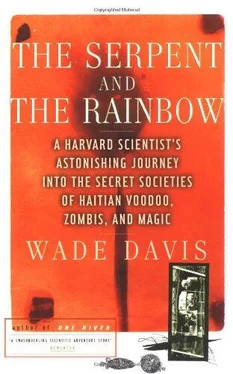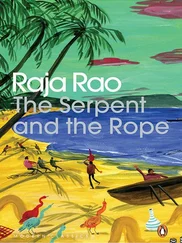Wade Davis - The Serpent and the Rainbow
Здесь есть возможность читать онлайн «Wade Davis - The Serpent and the Rainbow» весь текст электронной книги совершенно бесплатно (целиком полную версию без сокращений). В некоторых случаях можно слушать аудио, скачать через торрент в формате fb2 и присутствует краткое содержание. Год выпуска: 1985, Издательство: Simon & Schuster, Жанр: Старинная литература, на английском языке. Описание произведения, (предисловие) а так же отзывы посетителей доступны на портале библиотеки ЛибКат.
- Название:The Serpent and the Rainbow
- Автор:
- Издательство:Simon & Schuster
- Жанр:
- Год:1985
- ISBN:нет данных
- Рейтинг книги:5 / 5. Голосов: 1
-
Избранное:Добавить в избранное
- Отзывы:
-
Ваша оценка:
- 100
- 1
- 2
- 3
- 4
- 5
The Serpent and the Rainbow: краткое содержание, описание и аннотация
Предлагаем к чтению аннотацию, описание, краткое содержание или предисловие (зависит от того, что написал сам автор книги «The Serpent and the Rainbow»). Если вы не нашли необходимую информацию о книге — напишите в комментариях, мы постараемся отыскать её.
The Serpent and the Rainbow — читать онлайн бесплатно полную книгу (весь текст) целиком
Ниже представлен текст книги, разбитый по страницам. Система сохранения места последней прочитанной страницы, позволяет с удобством читать онлайн бесплатно книгу «The Serpent and the Rainbow», без необходимости каждый раз заново искать на чём Вы остановились. Поставьте закладку, и сможете в любой момент перейти на страницу, на которой закончили чтение.
Интервал:
Закладка:
Even within her first weeks in Haiti, as she moved at will through the streets of Port-au-Prince, Zora Neale heard the whispers running along the front edge of the night. They came at first alone, single incidents without any obvious pattern. First there was the drum that sounded one Thursday above her village, a rapid staccato beat, highly repetitious and unlike any rhythm she had heard in a hounfour. She woke up her housegirl and suggested they investigate, much as they had done many times before. But instead of the eager companion she had grown accustomed to, Zora Neale beheld for the first time a trembling child, unwilling to step beyond the threshold of their doorway. Then some weeks later, again at night, Hurston was disturbed by the acrid smell of burning rubber in her yard. When she questioned the man responsible, he apologized profusely but explained that the fire was necessary to drive away those who planned to take his child, the Cochons Gris , or Gray Pigs, who he claimed ate people. Apparently he had already seen them parading by the house, figures draped in red gowns and hoods. Yet a third incident occurred on a sailboat en route to the island of La Gonave, when she encountered a force of militia moving in to suppress some society based in a remote region of the island. No details were provided, just a few words followed by a hush of uneasiness, which Hurston interpreted as fear. Finally back in the capital, a contact led her to the house of a houngan in the Bel Air slum, and there she saw a temple unlike anything she had known. At the center of the sanctum was an immense black stone attached to a heavy chain, which in turn was held by an iron bar whose two ends were buried in the masonry of the wall. As she stood before the stone, her host handed her a paper, yellow with age and patterned with cabalistic symbols, and a “mot de passage”— password of the secret society known as the Cochons Gris.
Following these and other leads, Zora Neale over the course of several months managed to put together an astonishing portrait of the Haitian secret societies. According to her informants they met clandestinely at night, called together by a special high-pitched drumbeat; members recognized each other by means of ritualized greetings learned at initiation, and by identification papers—the passports. In a vivid description of a nocturnal gathering, she mentions a presiding emperor accompanied by a president, ministers, queens, officers, and servants, all involved in a frenzied dance and song ritual that she likens to the “sound and movement of hell boiling over.” The entire throng formed a procession and marched through the countryside, saluting the spirits at the crossroads, picking up additional members before convening in the cemetery to invoke Baron Samedi, the guardian of the graveyard, and beg him to provide a “goat without horns” for the sacrifice. With the spirits’ permission, scouts armed with cords made from the dried entrails of victims combed the land for some traveler foolish enough to be still journeying after dark. If the unfortunate wayfarer was unable to produce a passport indicating his membership in a society, and thus his right to move by night, he was taken to be punished.
Unfortunately, it appears from her writings at least that Hurston was never able to attend one of these gatherings herself. Perhaps because of this she was unable to get beyond the public face of the societies, an image that cast them in the words of a later ethnographer as “bands of sorcerers, criminals of a special kind.” A member of the mulatto elite, for example, told Hurston:
We have a society that is detestable to all the people of Haiti. It is known as the Sect Rouge, Vinbrindingue and Cochons gris and all these names mean one and the same thing. They are banded together to eat human flesh…. These terrible people were kept under control during the French period by the very strictures of slavery. But in the disturbances of the Haitian period, they began their secret meetings and were well organized before they came to public notice. … It is not difficult to understand why Haiti has not even yet thoroughly rid herself of these detestable creatures. It is because of their great secrecy of movement on the one hand and the fear that they inspire on the other…. The cemeteries are the places where they display the most horrible aspects of their inclinations. Some one dies after a short illness, or a sudden indisposition. The night of the burial the Vinbrindingues go to the cemetery, the chain around the tomb is broken and the grave profaned … and the body spirited away.
Yet who were these secret societies? Zora Neale Hurston never really says. She concludes simply by emphasizing that they are secret, and that the very lives of their members depend upon the confidence of the group. But she also, rather remarkably, describes what she could not have realized was the primary method of zombification. “There is,” she writes, “swift punishment for the adept who talks. When suspicion of being garrulous falls upon a member, he or she is thoroughly investigated, but with the utmost secrecy without the suspect knowing that he is suspect. But he is followed and watched until he is either accounted innocent or found guilty. If he is found guilty, the executioners are sent to wait upon him. By hook or crook, he is gotten into a boat and carried out beyond the aid and interference from the shore. After being told the why of the thing, his hands are seized by one man and held behind him, while another grips his head under his arm. A violent blow with a rock behind the ear stuns him and at the same time serves to abrase the skin. A deadly and quick-acting poison is then rubbed into the wound. There is no antidote for the poison and the victim knows it.”
It wasn’t until almost forty years later that a young Haitian anthropologist by the name of Michel Laguerre managed to begin to answer some of the questions raised by Hurston’s fieldwork. In the summer of 1976, Laguerre met a number of peasants who had been invited to join the secret societies, but who later had converted to Protestantism and hence were willing to talk. There were, according to these informants, secret societies in all parts of the country, and each one maintained control of a specified territory. Names varied from region to region but included Zobop, Bizango, Vlinbindingue, San Poel, Mandingue, and, most interestingly, Macandal. Membership was by invitation and initiation, open to men and women, and was strictly hierarchical. Laguerre verified the existence of passports, ritual handshakes and secret passwords, banners, flags, and brilliant red-and-black uniforms, as well as a specialized body of spirits, songs, dances, and drumbeats. He also noted the central importance of the cyclical rituals performed to strengthen the solidarity of the group: gatherings that occur only at night, that begin with an invocation to the spirits and end with the members in procession, flowing beneath the symbol of the society, the sacred coffin known as the sekey madoulè .
But according to Laguerre the function of the secret societies was unlike anything reported by Hurston. In no way could they be considered criminal organizations. On the contrary, he described them as the very conscience of the peasantry, a quasi-political arm of the vodoun society charged above all with the protection of the community. Like the secret societies in West Africa, those of Haiti seemed to Laguerre to be the single most important arbiter of culture. Each one was loosely attached to a hounfour whose houngan was a sort of “public relations man” acting as a liaison between the clandestine society and the world at large. In fact, so ubiquitous were the societies that Laguerre described them as nodes in a vast network that, if and when linked together, would represent a powerful underground government capable of competing head-on with the central regime in Port-au-Prince. And of the origin of these secret societies, Michel Laguerre had no doubts.
Читать дальшеИнтервал:
Закладка:
Похожие книги на «The Serpent and the Rainbow»
Представляем Вашему вниманию похожие книги на «The Serpent and the Rainbow» списком для выбора. Мы отобрали схожую по названию и смыслу литературу в надежде предоставить читателям больше вариантов отыскать новые, интересные, ещё непрочитанные произведения.
Обсуждение, отзывы о книге «The Serpent and the Rainbow» и просто собственные мнения читателей. Оставьте ваши комментарии, напишите, что Вы думаете о произведении, его смысле или главных героях. Укажите что конкретно понравилось, а что нет, и почему Вы так считаете.












